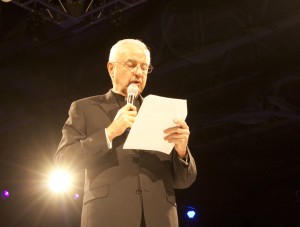For cash-strapped students, news of another tuition increase for the 2013-2014 school year on the heels of the wildly successful $515 million Opening Doors Capital Campaign seemed contradictory.
In fact, current students probably won’t see the benefits in the form of lowered tuition from the capital campaign because two-thirds of the money is pledges and bequests, and donor preferences dictate where it ends up.

Junior Keeley Norton said as an admissions worker and student, she understands why the university needs to raise tuition despite the Opening Doors campaign.
“Tuition at all private schools raises every year, and St. Thomas has to go at the same rate as well. Do I like the tuition increase? No. Does it make sense? Yes,” Norton said. “It shows we hold (educators) in a high regard.”
Besides the brick and mortar projects like the Anderson Student Center, Anderson Athletic and Recreation Complex, Flynn Residence Hall and others that have already been completed, students will need to wait to see campaign results.
Chief Financial Officer Mark Vangsgard said the pledges will come to fruition in one to 20 years. Vangsgard said the donations that the university has access to now were allotted based on the donors’ requests.
“For example, if St. Thomas decided to start a medical school, tuition would not increase because that would come from money from donors and the money they asked to set aside for it,” Vangsgard said.
St. Thomas tuition covers the university’s operating costs, and 75 percent of those costs deal with salaries and benefits for employees. Vangsgard said the remaining 25 percent goes to services the university decides the students want, such as the new dining options in the Anderson Student Center.
“As a non-profit organization, St. Thomas is concerned about any tuition increases, undergraduate or graduate,” Vangsgard said. “We’re comfortable doing it when we feel it covers what the students want.”
As for waiting on campaign funds, Norton said the Opening Doors campaign results might have been a little misleading.
“The fact that St. Thomas raised so much money is worth-knowing and adds prestige to the university, but I would rather they let us know up-front that students that are currently attending will not really benefit from this campaign,” Norton said.
Sophomore Jake Ekhaml said he is glad the capital campaign will benefit students down the line, but he is concerned about tuition rates now.
“I’m already in debt,” Ekhaml said. “I knew that another increase was coming down the line, and I already have to deal with it, but I wish that the campaign money would kick in sooner.”
Ekhaml echoed Norton’s thoughts on the publicity of the pledges and bequests.
“It could have been something that the university had let us know,” Ekhaml said. “It realistically wouldn’t have helped me much at this point.”
Anastasia Straley can be reached at stra0669@stthomas.edu.

